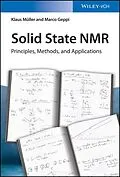Solid State NMR
A thorough and comprehensive textbook covering the theoretical background, experimental approaches, and major applications of solid-state NMR spectroscopy
Nuclear Magnetic Resonance (NMR) spectroscopy is a powerful non-destructive technique capable of providing information about the molecular structure and dynamics of molecules. Alongside solution-state NMR, a well-established technique to study chemical structures and investigate physico-chemical properties of molecules in solutions, solid-state NMR (SSNMR) offers many exciting possibilities for the analysis of solid and soft materials across scientific fields. SSNMR shows unique capabilities for a detailed investigation of structural and dynamic properties of materials over wide space and time ranges. For this reason, and thanks to significant advances in the past several years, the application of SSNMR to materials is rapidly increasing in disciplines such as chemistry, physics, and materials and life sciences.
Solid State NMR: Principles, Methods, and Applications offers a systematic introduction to the theory, methodological concepts, and major experimental methods of SSMR spectroscopy. Exploring the unique potential of SSNMR for the structural and dynamic characterization of soft and either amorphous or crystalline solid materials, this comprehensive textbook provides foundational knowledge and recent developments of SSNMR, covering physical and theoretical background, experimental methods, and applications to pharmaceuticals, polymers, inorganic and hybrid materials, liquid crystals, and model membranes. Written by two expert authors to ensure a clear and consistent presentation of the subject, this textbook:
- Includes a brief introduction to the historical aspects and broad theoretical background of solid-state NMR spectroscopy
- Provides helpful illustrations to explain the various SSNMR concepts and methods
- Features accessible descriptive text with self-consistent use of quantum mechanics
- Covers the experimental aspects of SSNMR spectroscopy and in particular a description of many useful pulse sequences
- Contains references to relevant literature
Solid State NMR: Principles, Methods, and Applications is the ideal textbook for university courses on SSNMR, advanced spectroscopies, and a valuable single-volume reference for spectroscopists, chemists, and researchers in the field of materials.
Autorentext
Marco Geppi, PhD, is a Professor of Physical Chemistry in the Department of Chemistry and Industrial Chemistry at the University of Pisa, Italy, where he leads the solid-state NMR group.
Klaus Müller, PhD, was a Professor of Physical Chemistry at the University of Stuttgart, Germany. Now deceased, Professor Müller's main research activities were applications of solid-state NMR techniques for the characterization of different types of materials.
Klappentext
Handlich, übersichtlich und umfassend: Dieses Buch deckt die theoretischen und methodischen Prinzipien der Festkörper-NMR ab und demonstriert ihre Anwendungen an zahlreichen Beispielen (Biomaterialien, Polymere, anorganische Stoffe). Abgerundet wird der zum Lernen und Nachschlagen geeignete Text durch Fachworterklärungen, Zusammenfassungen an den Kapitelenden und ein ausführliches Literaturverzeichnis.
Inhalt
Foreword xiii
Preface xv
Foreword xvii
1 Introductory NMR Concepts 1
1.1 Historical Aspects 1
1.2 Basic Description of NMR Spectroscopy 5
1.2.1 Nuclear Spins and Nuclear Zeeman Effect 8
1.2.2 Spin Ensembles 11
1.2.3 Single Pulse Experiment, Bloch Equations, and Fourier Transformation 17
1.2.4 Populations and Coherences 27
1.3 Liquid-state NMR Spectroscopy: Basic Concepts 29
1.3.1 Chemical Shift 29
1.3.2 Indirect SpinSpin Coupling and Spin Decoupling 32
1.3.3 Nuclear Spin Relaxation 38
1.3.4 Nuclear Overhauser Effect 44
1.4 Liquid-state NMR Spectroscopy: Some Experiments 47
1.4.1 Relaxation Experiments 47
1.4.2 Insensitive Nuclei Enhanced by Polarization Transfer 53
1.4.3 2D NMR Spectroscopy 53
1.4.4 Chemical Exchange 57
1.5 Solid Materials and NMR Spectroscopy 63
References 69
2 Mathematical and Quantum-mechanical Tools 73
2.1 Definitions and Basic Concepts 73
2.1.1 Operators and Functions 73
2.1.2 Eigenvalue Equations 74
2.1.3 Eigenstates and Superposition States: Pure and Mixed Ensembles 75
2.1.4 Nuclear Spin and Angular Momentum 76
2.2 Rotations and Frame Transformations 77
2.2.1 Active and Passive Transformations 78
2.2.2 Rotation Operators 78
2.2.3 Rotation Matrices and Euler Angles 79
2.3 Time-Independent Features: Energy Levels and Related Aspects 81
2.3.1 Time-Independent Schrödinger Equation and Spin Hamiltonians 81
2.3.2 Time-Independent Perturbation Theory 81
2.3.3 Matrix Representation of Operators and Density Matrix Theory 83
2.3.3.1 Isolated Nucleus with Spin 1/2 84
2.3.3.2 Isolated Nucleus with Spin 1 87
2.3.3.3 Pair of Coupled Nuclei with Spin 1/2 87
2.3.4 Spin Temperature 89
2.4 Dealing with Time Dependence 90
2.4.1 Time-Dependent Schrödinger and Liouvillevon Neumann Equations 90
2.4.2 Average Hamiltonian Theory 91
References 93
3 Nuclear Spin Interactions 95
3.1 Introduction 95
3.2 Interactions with External Magnetic Fields 97
3.3 Internal Interactions 100
3.3.1 Shielding or Chemical Shift Interaction 100
3.3.2 Knight Shift Interaction 105
3.3.3 Quadrupolar Interaction 106
3.3.4 Dipolar Coupling 112
3.3.5 Indirect SpinSpin (J) Coupling 116
3.3.6 Paramagnetic Coupling 117
References 119
4 Broadline NMR Spectroscopy 121
4.1 Introductory Remarks 121
4.2 Finite Pulse Duration and Adiabatic Pulses 133
4.2.1 Finite Pulse Duration: Excitation Profile and Spectral Distortions 133
4.2.2 Adiabatic Pulses 138
4.3 Inhomogeneous and Homogeneous Line Broadening Mechanisms 141
4.4 Dilute Spin-1/2 Nuclei 142
4.4.1 Broadline NMR Spectra 142
4.4.2 Cross-polarization 149
4.4.2.1 Pulse Sequence and HartmannHahn Conditions 149
4.4.2.2 CP Explained by AHT 151
4.4.2.3 CP Explained by the Thermodynamic Model 157
4.4.2.4 CP Dynamics 160
4.4.2.5 CP-related Techniques 167
4.4.3 Heteronuclear Spin Decoupling 169
4.4.3.1 CWHeteronuclear Spin Decoupling Explained by AHT 171
4.4.3.2 Beyond CW: Off-resonance Effects and Pulse Decoupling Schemes 172
4.4.4 Echo Experiments 176
4.5 Abundant Spin-1/2 Nuclei 184
4.5.1 Broadline NMR Spectra 184
4.5.2 Spin Diffusion 187
4.5.2.1 Fick's Equation of Diffusion 187
4.5.2.2 The GoldmanShen Experiment 189
4.5.2.3 Influence of Spin Diffusion on Spin-Lattice Relaxation Times 191
4.5.3 Moment Analysis 192
4.5.4 Echo Experiments for Refocusing the Homonuclear Dipolar Interaction 194
4.5.4.1 Soli...
